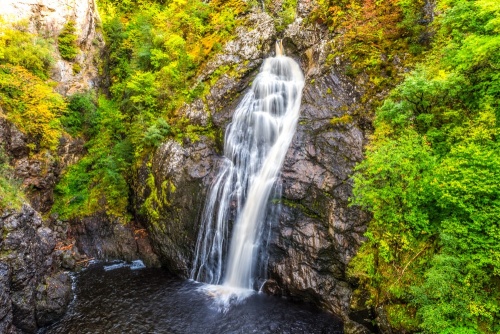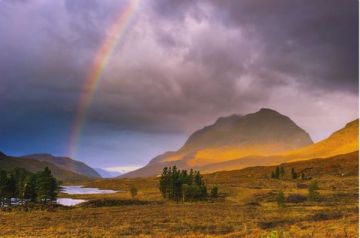
Among the heathy hills and ragged woods
The roaring Foyers pours his mossy floods
Robert Burns, 1787
The Falls of Foyers is a dramatic waterfall in a beautiful woodland setting at Foyers, on the 'quiet side' of Loch Ness.
The falls are reached by a path through beautiful woodland. Along the path are rocks inscribed with verses written by poets who were inspired by visits to Foyers.
Among those poets was Robert Burns who came here in 1787 and was so moved by the sight of the tumbling water that he pulled out a pencil and wrote a verse on the spot. Burns described the waterfall as falling through 'rising mists and ceaseless showers' to a 'horrid cauldron' below.

Before Burns came to Foyers Dr Johnson and his biographer James Boswell visited the Falls in 1773 and described the waterfall as 'a channel torn, as it seems, through black piles of stone'.
It was not an easy task for visitors to the waterfall in Burns' day. There was no pleasant path as there is today and travellers were forced to scramble down a muddy, slippery bank.
A visitor in 1799 wrote that 'The noise was beyond belief. I met four male travellers who came tumbling and slipping down the banks with fright and dismay. I slipped, and hung on by trees and clung to pieces of rock, until I got down on the desired bank'.
These visitors came via General Wade's military road, built in the 1730s to aid troop transport in the event of another Jacobite rebellion.

Things got easier in the 19th century when paddle steamers made regular trips up and down the loch, allowing holidaymakers to get views of the Falls from on board. In 1862 a pier was built at Foyers so they could alight and climb up to the Falls on foot or take a horse-drawn carriage.
It was only in the 1830s that a safe path was built and then only because an aristocratic visitor was so frightened by the dangerous descent to the waterfall that he put up £5 towards the cost of building a path. The remaining £45 was raised by a civil engineer named Joseph Mitchell.
The Falls we see today are dramatic - especially after heavy rains - but are not as Robert Burns would have seen them. Some of the water from the River Foyers has been channelled underground to hydro-electric turbines at Lower Foyers near the shore.
These turbines were originally installed to power the first UK's first aluminium smelter, built in 1896, but now feed renewable green energy into the national grid.
The Foyers aluminium smelter produced aircraft parts during WWII. That made it a target for German bombs. The factory was bombed in 1941 and two people were killed.

Foyers Wood
The woodland here abounds in ash, oak and Scots pine. During the Victorian period, the slope was planted with rhododendron. Though it added to the beauty of the site the rhododendron sadly pushed out native plants and mosses. Much of the rhododendron has now been cleared, allowing native species to return.
Roe deer are common here in spring, grazing on wild primroses, bluebells and violets amongst the trees. Bats are frequently seen as dusk falls, especially on the lower slopes near the shore, and pine martens are common visitors.
The most famous resident animal, however, is the red squirrel. There is a special Red Squirrel Trail through the woods.

Getting There
The Falls are extremely easy to reach. Foyers is most easily reached from Fort Augustus via the B862. There is a free parking area beside the village cafe and shop at the south-eastern end of the village. Directly across from the cafe is a gate with an information panel and a large sign for the Falls of Foyers.
Follow the signposted trail downhill to a fork in the trail. Bear left at the fork to reach the upper viewpoint then carry on downhill again to the second viewpoint, looking up at the falls.
We've been to the Falls of Foyers several times and really enjoy the experience. It isn't the easiest place to get to, but the very fact that it is on the quieter south-eastern side of Loch Ness means that it isn't crowded. The woodlands are beautiful and after rains the waterfall is stunning.
The Falls of Foyers is included in our list of 22 Beautiful Scottish Waterfalls.
About Falls of Foyers
Address: B862,
Foyers,
Loch Ness,
Highlands,
Scotland
Attraction Type: Countryside - Waterfall
Location: Access by trail opposite the parking area beside the village shop and cafe. The nearest postcode is IV2 6XX.
Location map
OS: NH497203
Photo Credit: David Ross and Britain Express
HERITAGE
 We've 'tagged' this attraction information to help you find related historic attractions and learn more about major time periods mentioned.
We've 'tagged' this attraction information to help you find related historic attractions and learn more about major time periods mentioned.
Find other attractions tagged with:
Robert Burns (Person) -
NEARBY HISTORIC ATTRACTIONS
Heritage Rated from 1- 5 (low to exceptional) on historic interest
Wade's Bridge - 3.2 miles (Historic Building) ![]()
John Cobb Memorial - 4.2 miles (Historic Building) ![]()
Divach Falls - 4.4 miles (Countryside) ![]()
St Columba's Holy Well, Invermoriston - 5.2 miles (Historic Church) ![]()
Urquhart Castle - 5.5 miles (Castle) ![]()
Loch Ness - 6.1 miles (Countryside) ![]()
Loch Ness Centre - 6.1 miles (Museum) ![]()
Allt na Criche Waterfall - 8.9 miles (Countryside) ![]()
Nearest Holiday Cottages to Falls of Foyers:
Nearby accommodation is calculated 'as the crow flies' from Falls of Foyers. 'Nearest' may involve a long drive up and down glens or, if you are near the coast, may include a ferry ride! Please check the property map to make sure the location is right for you.
Foyers, Highlands and Islands
Sleeps: 2
Stay from: £360.00 - 1594.00
Foyers, Highlands and Islands
Sleeps: 2
Stay from: £371.00 - 1375.00
Foyers, Highlands and Islands
Sleeps: 6
Stay from: £603.00 - 2722.00
More self catering near Falls of Foyers



